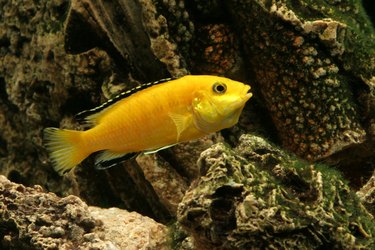
A vivid addition to any freshwater aquatic community, the African cichlid's vibrant colors and unique behaviors delight their owners. Most types of African cichlids are sexually dimorphic, which means that males will appear different from females. Close examination of the shape of the fish's genital papilla, visible near spawning time, is the most certain means of determining cichlid gender.
Cichlid Sizes and Shapes
Video of the Day
In most types of cichlid fish, the male will be larger than the female, measuring up to a full inch inch longer. The dorsal, anal and caudal fins of the male fish may be longer in certain species, according to the Fish Channel. In isomorphic species, the male will be slightly larger than the female, but the female's belly will appear round in comparison to that of the male.
Video of the Day
Colors and Markings
As with many dimorphic species, brightly colored cichlids are usually male. Striping, if present, may occur on both male and female fish. Still other cichlid males develop what are known as "egg spots" on their anal fins. This unique adaptation, present in East African haplochromine cichlids, is thought to represent male quality and may assist cichlids to attract a female, according to Oklahoma State University. Males lacking egg spots are often the target of interspecies aggression from other males.
Venting Cichlids
Examination of the vent, known otherwise as the genital papilla, is the only certain means of determining cichlid gender, particularly in monomorphic species where both fish look the same. The vent can be found between the anal fin and the fish's anus. Mouth-brooding females will have a vent that is large and easily distinguished, according to the Fish Head website. Pigment differences may be observed between male and female vents. The male may have an elongated papilla when compared to the female. For the safety of the fish, they should be out of the water no longer than 30 seconds, and attempts to determine their gender by venting should be performed no more than three times per fish. Responsible fish handlers wet their hands before handling fish for venting.
Fishy Behavior
When determining cichlid gender, a fish's behavior can be an important factor. A pair of fish attempting to spawn will swim together, whereas a group of female fish tend to ignore the presence of other cichlids, according to the Fish Channel. Male cichlids may exhibit flamboyant or even aggressive behavior, particularly before spawning. Their pursuit of creating a nest or cave for reproduction will be observed before they pair with a female. Breeding female cichlids often carry developing fry in their mouth for protection, and will readily harbor their young any time danger is present.